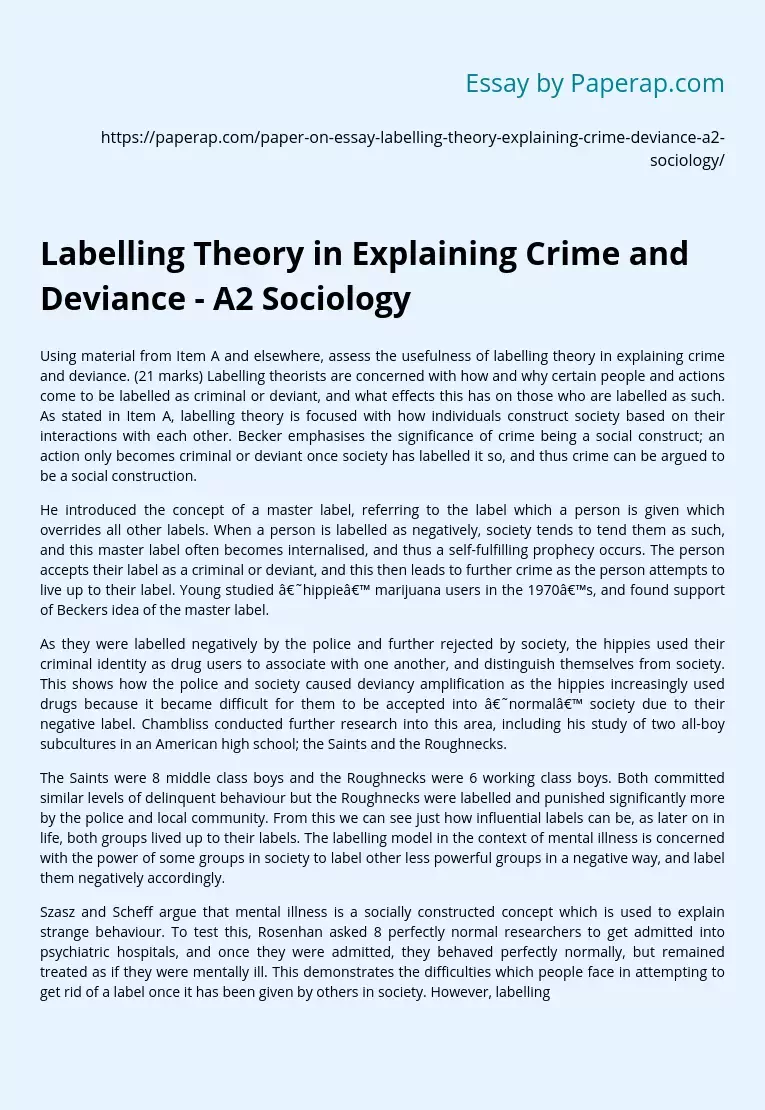Labelling Theory in Explaining Crime and Deviance - A2 Sociology
Using material from Item A and elsewhere, assess the usefulness of labelling theory in explaining crime and deviance. (21 marks) Labelling theorists are concerned with how and why certain people and actions come to be labelled as criminal or deviant, and what effects this has on those who are labelled as such. As stated in Item A, labelling theory is focused with how individuals construct society based on their interactions with each other. Becker emphasises the significance of crime being a social construct; an action only becomes criminal or deviant once society has labelled it so, and thus crime can be argued to be a social construction.
He introduced the concept of a master label, referring to the label which a person is given which overrides all other labels. When a person is labelled as negatively, society tends to tend them as such, and this master label often becomes internalised, and thus a self-fulfilling prophecy occurs. The person accepts their label as a criminal or deviant, and this then leads to further crime as the person attempts to live up to their label.
Young studied ‘hippie’ marijuana users in the 1970’s, and found support of Beckers idea of the master label.
As they were labelled negatively by the police and further rejected by society, the hippies used their criminal identity as drug users to associate with one another, and distinguish themselves from society. This shows how the police and society caused deviancy amplification as the hippies increasingly used drugs because it became difficult for them to be accepted into ‘normal’ society due to their negative label.
Chambliss conducted further research into this area, including his study of two all-boy subcultures in an American high school; the Saints and the Roughnecks.
The Saints were 8 middle class boys and the Roughnecks were 6 working class boys. Both committed similar levels of delinquent behaviour but the Roughnecks were labelled and punished significantly more by the police and local community. From this we can see just how influential labels can be, as later on in life, both groups lived up to their labels. The labelling model in the context of mental illness is concerned with the power of some groups in society to label other less powerful groups in a negative way, and label them negatively accordingly.
Szasz and Scheff argue that mental illness is a socially constructed concept which is used to explain strange behaviour. To test this, Rosenhan asked 8 perfectly normal researchers to get admitted into psychiatric hospitals, and once they were admitted, they behaved perfectly normally, but remained treated as if they were mentally ill. This demonstrates the difficulties which people face in attempting to get rid of a label once it has been given by others in society. However, labelling theory also receives many criticisms.
It tends to be deterministic, inferring that once someone has been labelled as criminal, a deviant career is inevitable, whilst also shifting blame from the individual who is committing crime. Additionally, whilst it offers a reasonable explanation as to why secondary deviance occurs, it fails to explain why primary deviance is committed in the first place, before they are labelled. An alternative explanation would be the Marxist approach, who argue that the causes of crime are not due to labelling, but due to the oppression which working class people face.
They argue that capitalism is criminogenic, as the very nature of capitalism is criminal as it is based on the exploitation of the working classes. By encouraging the values of self-interest and a mentality of greed, this encourages the working classes to commit crime in an attempt to obtain the same standard of living as those in the ruling classes . However, Postmodernists criticise both the labelling theory and Marxist perspectives of crime, as they argue that due to the complex diversity of modern society, it is impossible to generalise the causes of crime.
Instead they propose that each crime should be considered as a unique event and treated as such in order to provide an effective punishment. Conclusively, labelling theories are effective in explaining why those who receive negative labels often reoffend, due to the master label, deviancy amplification and finally the self-fulfilling prophecy. However, they fail to take into account several alternative explanations as to why individuals turn to a criminal lifestyle.
Labelling Theory in Explaining Crime and Deviance - A2 Sociology. (2019, Jun 20). Retrieved from https://paperap.com/paper-on-essay-labelling-theory-explaining-crime-deviance-a2-sociology/

